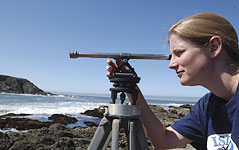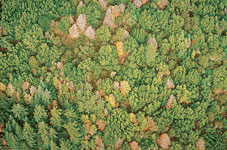Volume 26 · Number 1 · Fall 2008
100 Ways
that UC Davis Has Transformed the World
Biological sciences

Pollution.
We know more about the health risks of the air we breathe, thanks to UC Davis studies on secondhand cigarette smoke and children, pollution from traffic and agriculture, and the Sept. 11 dust that coated Manhattan around Ground Zero. And vet school researchers in the 1970s developed tools used by the U.S. Environmental Protection Agency to set national air-quality standards.

Plumbing the ocean.
A captive-rearing program for winter-run Chinook salmon has helped keep the species alive. That is one of the achievements of UC Davis’ Bodega Marine Laboratory, which performs crucial studies of ocean ecosystem problems, including abalone losses, the “ecosystem services” of sea grasses, marine upwelling and coastal climate change.
Endangered fish.
Led by California native fish authority Peter Moyle, studies of disappearing salmon, delta smelt and sturgeon have brought new protection to watersheds.
Living treasures.
UC Davis provides a reliable source of healthy and genetically diverse plants for the world. In 1958, a UC Davis program was created to maintain and distribute to commercial nurseries disease-free grapevines, tree fruits and nuts. That program, now known as Foundation Plant Services, has expanded to do the same for strawberries, sweet potatoes and roses. UC Davis is also home to a priceless tomato seed bank and the U.S. Department of Agriculture’s National Clonal Germplasm Repository, which archives rooted cuttings and budded rootstocks of a number of important plants.

Flora and fauna.
Trees, plants, weeds, insects, mammals, birds, fish — living and dead — UC Davis has millions, providing a reference and resource for the world. The arboretum’s 22,000 plants and trees include the Shields Oak Grove, renowned for its taxonomic diversity. The Center for Plant Diversity holds 250,000 dried and pressed plant specimens, and the campus’s botanical conservatory maintains more than 3,000 live specimens. Looking for critters? Try the Bohart Museum of Entomology (7 million specimens) or the Museum of Wildlife and Fish Biology (35,000-plus).
DNA discovery.
UC Davis researchers have developed technology to watch a single enzyme that unwinds DNA at work in real time. They have used the technique to gain new insights into the molecular machines that copy and repair DNA, a vital process in living cells that, when it goes awry, can lead to cancer.

DNA analysis.
The Veterinary Genetics Laboratory, first established as a blood-typing lab to verify parentage for horse and cattle registries, has pioneered DNA-based verification in many species, providing pedigree validation, diagnostic tests and genetic research in large animals, pets and wildlife species. The lab’s analyses of crime-scene data have aided agencies worldwide in their investigations.

Let there be sight.
People blind from damaged corneas had their vision restored with techniques developed at UC Davis, including the implant of artificial corneas and lenses and a new bioengineering technique in which replacement corneal tissue is grown in a laboratory dish.
DDT warning.
In the 1960s wildlife biologist Daniel Anderson was one of the first scientists to recognize how pesticides like DDT were linked to eggshell thinning and population declines in pelicans and cormorants. His work as a UC Davis faculty member from the 1970s to the present has continued to add to the understanding of environmental and human impacts on seabird populations — research that has been instrumental in the creation of ecological reserves in California and Baja California.
Saving Sierra forests.
UC Davis research in California forests helped shift public policy from encouraging commodity extraction to protecting natural resources. In particular, at the request of Congress in 1992, the Sierra Nevada Ecosystem Project assessed the ecological, economic and social value of this mighty Western mountain range. It was the first study to consider humans as part of an ecological system on such a large scale.
Plant life.
For decades, noted plant biologists at UC Davis have made contributions to our understanding of how plants evolve, grow, fight infections and pests, respond to light, absorb nutrients from the soil and turn sunlight into sugars. Their discoveries have opened new avenues for developing crops that could grow in cold, dark climates or salty soils, as well as reducing pesticide use, increasing crop yields and producing new sources of food oils and fuel. Moreover, these researchers have written classic textbooks, including one series with an 80-year publication span, that have helped train generations of new plant scientists around the world.

Environmental cleanup.
Faculty members’ novel methods for tracking the movement of chemicals in water, soil and air have been adopted worldwide. In 1961, UC Davis established the nation’s first environmental toxicology department outside of a medical school. Zoologist Robert Rudd’s book Pesticides and the Living Landscape was hailed as “the scientist’s Silent Spring.” And recent highlights include the cleanup of more than 10 tons of lost fishing gear to make the coastal ocean safer for wildlife.
Tailored modifications.
In the future, your doctor will look at your DNA profile before prescribing medicines and diets tailored specifically to your genes, thanks to work being done today at the Center of Excellence in Nutritional Genomics, led by UC Davis, the Children’s Hospital Oakland Research Institute and other partners.

Lake Tahoe.
UC Davis researchers are helping keep Lake Tahoe blue. Starting almost 50 years ago under the leadership of Charles Goldman, they were the first to warn that the lake ecosystem was in trouble and have led the search for solutions. Today two new UC Davis interpretive centers at the lake spread research findings to the general public and decision-makers.

Oak death.
UC Davis plant pathologist Dave Rizzo and a colleague discovered what has killed millions of oak trees in California, and they are now trying to figure out how to fully control it. The effort took on new urgency this summer when wildfires tore through California, including at Big Sur, where sudden oak death has left so much deadwood that the fires there likely burned hotter and with more intensity.

A world of alumni.
From the time the first students graduated in 1911, UC Davis alumni have been making their mark in the world — and beyond. Among their countless achievements are winning Olympic gold medals, directing Oscar-winning Disney films, heading UNICEF and flying through space as astronauts. With every year, the Aggie impact multiplies. From nine students in the 1911 class, our living alumni total has grown to 185,000.
« Return to 100 ways introduction

